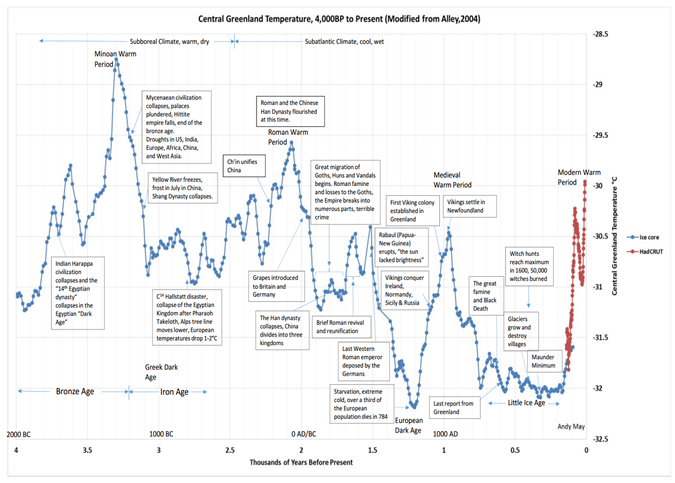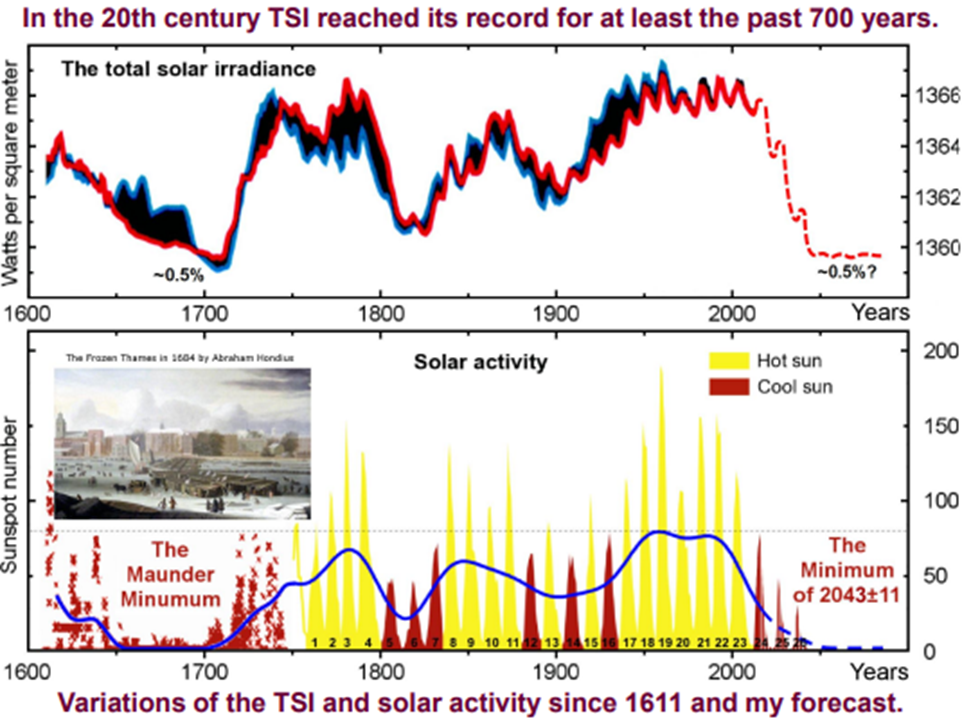With all the sound and fury about global warming, an important, and many scientists now assert, more likely scenario is usually ignored-the possibility of far more dangerous global cooling. It is more dangerous because many more people die due to the cold than the heat. A 2015 study in the British Medical journal The Lancet found that:
Cold weather kills 20 times as many people as hot weather, according to an international study analyzing over 74 million deaths in 384 locations across 13 countries.
Indeed, history shows that cold periods are far more hazardous than warm times. That is why geologists call past warm epochs "optimums" and cold times "dark ages." The plot of temperature versus time for Central Greenland below (used with the permission of the originator, petrophysicist Andy May) is a good illustration of the natural climate change we have seen over the past four thousand years and the related societal impacts. Note how cold periods coincided with hardships for humanity while, in most cases, warm periods were beneficial.
Advertisement

Yet cities such as Ottawa, Chicago, Detroit, Minneapolis, and Montreal, municipalities each of which experience cold weather, at times very cold, all essentially ignore the dangerous impacts of cooling in their climate change plans. Ottawa's Climate Change Master Plan is especially misguided. Despite the City's assertion that "Ottawa must be an energy-conscious city where people can live, work and play in all future climate conditions," cooling adaptation is entirely ignored. As I told the City of Ottawa Environment and Climate Change Committee in my April 18, 2023 testimony:
As the seventh coldest capital city in the world, it is irresponsible for Ottawa to only prepare for warming when cooling is far more dangerous and, some scientists say, more likely. It would be like going camping in an area known to be infested with black bears and mosquitos and only planning for the mosquitos. Yes, the bugs can drive you crazy, but the bears can kill you. Similarly, heat in Ottawa is not fatal except for the elderly and other vulnerable citizens, people we need to protect. But everyone can die when it is minus 30 with no heat.
In my articles of past weeks, I have written about the new theory of cosmoclimatology-how phenomena in space, especially changes in the output of the Sun, affect the climate on Earth. While it is scientifically interesting to learn about what drove climate change in the past, what really matters from a public policy perspective is what this research can tell us about climate change in the future. This then helps us make sensible decisions about where we should focus our efforts to ensure future generations are well-prepared for whatever nature throws at us next.
As I explained in previously, Earthly temperature trends apparently follow in accordance with solar cycles. This should seriously concern councillors from all of these cities since leading solar researchers are convinced that we are headed for a Grand Solar Minimum by about the year 2070 when the Sun may be at its weakest in the past 300 years. This could result in significant global cooling, which these municipalities must prepare for.
The first time I heard about the coming Grand Solar Minimum was at The Heartland Institute's Fourth International Conference on Climate Change (ICCC-4) that took place in May 2010 in Chicago. In that important conference, Dr. Habibullo Abdussamatov, a Russian expert in solar terrestrial physics, head of the Space Research Laboratory of the Pulkovo Observatory in St. Petersburg and, later, the 2013 gold medal winner from the European Scientific-Industrial Chamber, gave a presentation titled, "THE SUN DICTATES THE CLIMATE." Abdussamatov explained that:
Advertisement
Natural bicentennial variations in the average annual values of the TSI [Total Solar Irradiance, the amount of solar energy reaching the top of Earth's atmosphere] caused by cyclic variations in the radius of the Sun together with secondary feedback effects led to 18 Little Ice Ages, established within the last 7,500 years. Every time the TSI experienced its peak (up to 0.2%) a global warming began with a time lag of 15+/-6 years defined by thermal inertia of the Ocean (despite the absence of anthropogenic influence [i.e., climate changed caused by humans]) and each deep bicentennial descent in the TSI caused a Little Ice Age.
Amazingly, Abdussamatov said that the Sun's radius varies by up to 250 km during the familiar 11-year sunspot cycle (we are just starting cycle 25 now) and up to 700 km during the bicentennial, or 200-year cycle. And this greatly influences solar output. Specifically, when the Sun was very weak, every 200 years or so, the Earth went into a Little Ice Age. He explained that such research enables scientists to study how TSI has changed in past centuries and even millennia and determine how it correlates with past climate on Earth and so what the future holds as these cycles continue.
Frighteningly, we are nearing a Grand Solar Minimum right now, a time period when many of the cycles of the Sun hit rock bottom. Abdussamatov predicted a deep minimum in TSI about 2042 and "a deep global temperature minimum about 2055 – 2060. The last time the Sun was this weak, the Earth was in a particularly cold phase of the most recent Little Ice Age that lasted from about 1350 – 1850, a period ofgreat misery for people around the world.
Abdussamatov gave a similar talk at The Ninth International Conference on Climate Change, which took place in 2014 in Las Vegas. The conference attracted some 650 scientists, economists, policy experts and Abdussamatov's presentation was more assertive this time and was titled "2014- The Beginning of the New Little Ice Age." In that talk, he updated his estimates to the start of the Grand Minimum of TSI being anticipated by about solar cycle 27 around the year 2043 which would be followed by "a phase of deep cooling [similar to] the 19th Little Ice Age … approximately in 2060 ± 11 [years], with possible duration of 45 – 65 years." He also presented the following graph:

Abdussamatov concluded his 2014 presentation:
The Sun is the main factor controlling the climatic system and it is more powerful than abilities of human beings.
In 2020, Abdussamatov published a block-buster paper, "Energy Imbalance Between the Earth and Space Controls the Climate" in the journal "Earth Sciences." Once again, he did not pull his punches and repeated his forecast of a Grand Solar Minimum by about 2043. The Russian scientist slightly updated his prediction of when we could expect the next Little Ice Age to really bite hard:
Solar cooling has started. As a result, the Earth has, and will continue to have, a long negative energy balance, which will ensure a slight decrease in temperature. However, this slight decrease in temperature is extremely important as a trigger mechanism for the subsequent chain effects of secondary causal effects of feedback that will greatly enhance the cooling. This will certainly lead to the onset of a phase of deep cooling of the climate approximately in the year 2070 ± 11 [years].
and
The total rate decline in TSI from cycle to cycle is currently accelerating and will reach maximum its acceleration in the next solar cycle. The observed consistent downward trend decline of TSI in four consecutive cycles suggests that such a decrease bring backs to a similar decrease during the Maunder minimum in 1645-1715.
Some people may be tempted to dismiss Dr. Abdussamatov's forecasts, as well as the work of Svensmark, Veizer and Shaviv that I discussed in the past two articles as unique in the scientific community. However in "Modern Grand Solar Minimum will lead to terrestrial cooling" in the August 4, 2020 edition of the journal Temperature, Northumbria University professorValentina Zharkova who holds a Ph.D. from the Solar Division of the Main Astronomical Observatory, Kyiv, Ukrainewrote:
During this modern grand minimum, one would expect to see a reduction of the average terrestrial temperature by up to 1.0°C, especially, during the periods of solar minima between the cycles 25–26 and 26–27, e.g. in the decade 2031–2043.
And then there is the 2021 paper, "How much has the Sun influenced Northern Hemisphere temperature trends? An ongoing debate" by 23 scientists from 14 countries, the abstract of which reads, in part:
It appears that previous studies (including the most recent IPCC reports) which had prematurely concluded [that the Sun's output contributed negligibly to Earthly climate change] had done so because they failed to adequately consider all the relevant estimates of Total Solar Irradiance and/or to satisfactorily address the uncertainties still associated with Northern Hemisphere temperature trend estimates.
And I could name many more scientists who also attribute most recent climate change to variations in TSI. Contrary to the claims of climate activists that "the science of climate change is settled," the science is very much unsettled and quickly evolving in directions that will make today's climate scare look like a dangerous and expensive mistake.